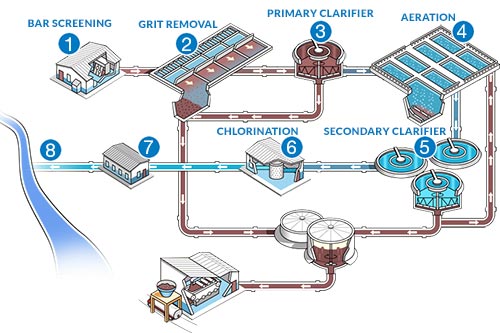How Wastewater Treatment Helps Enhance Resource Reuse Capabilities
How Wastewater Treatment Helps Enhance Resource Reuse Capabilities
Blog Article
Comprehending Wastewater Therapy Processes and Their Ecological Influence
The details of wastewater therapy processes play a pivotal duty in mitigating environmental challenges connected with water pollution. Each stage, from preliminary to sophisticated therapies, is created to deal with particular contaminants, eventually securing both public wellness and aquatic communities. In spite of technical innovations in treatment performance, significant difficulties persist, including the administration of recurring toxins and the effects of nutrient drainage. As we discover the complexities of these processes, it ends up being vital to wonder about exactly how much existing methods can develop to meet the expanding demands of sustainability and ecological conservation.
Overview of Wastewater Treatment
How is wastewater transformed into a risk-free resource for the atmosphere? Wastewater therapy is an important procedure created to get rid of contaminants from made use of water, therefore guarding public health and protecting ecological communities. This procedure starts with the collection of wastewater from property, commercial, and industrial resources, which is then directed to therapy facilities.
At these facilities, numerous physical, chemical, and biological methods are utilized to deal with the wastewater. Subsequently, biological therapies, such as activated sludge processes, use microbes to break down organic issue.
The treated effluent can be safely released right into natural water bodies or reused for irrigation and commercial purposes, promoting source preservation. Additionally, the treatment procedure creates biosolids, which can be repurposed as fertilizers or soil changes, better enhancing sustainability.
Stages of Treatment Procedures
The wastewater therapy procedure normally includes three primary stages: preliminary, main, and second therapy. Each phase serves a distinct role in minimizing the toxin load and making sure the effluent fulfills ecological standards before discharge.

The key treatment stage concentrates on the physical splitting up of suspended solids from the wastewater. With sedimentation, larger fragments resolve at the end of sedimentation tanks, forming sludge, while lighter products, such as oils and greases, float to the surface area and are skimmed. This procedure dramatically lowers the natural and inorganic load in the wastewater.
Secondary therapy is an organic process aimed at more lowering the focus of raw material. Numerous techniques, including activated sludge systems and flowing filters, use microorganisms to metabolize natural contaminants. This stage is important for achieving the essential biochemical oxygen demand (BOD) decrease, eventually leading to cleaner effluent all set for discharge or additional treatment. Each phase is vital in protecting ecological and public health and wellness.

Advanced Treatment Technologies
Complying with the secondary treatment procedures, advanced therapy technologies play an essential function in more improving the top quality of treated wastewater. These modern technologies are designed to eliminate recurring contaminants that are not properly eliminated during key and secondary therapies, ensuring the effluent satisfies rigorous regulatory requirements.
Amongst the widely used innovative treatment methods are membrane layer purification, reverse osmosis, and progressed oxidation processes. Membrane layer purification, consisting of microfiltration and ultrafiltration, is effective in separating great fragments, pathogens, and colloids from the water (Wastewater). Reverse osmosis uses semi-permeable membrane layers to get rid of dissolved solids, leading to high-quality water suitable for different applications
Advanced oxidation processes (AOPs) utilize solid oxidants to weaken organic pollutants, including pharmaceuticals and personal care products that are resistant to conventional treatment. These techniques improve the biodegradability of complicated compounds, facilitating their removal.
One more considerable innovation is using organic nutrient elimination processes, which particularly target nitrogen and phosphorus, protecting against eutrophication in obtaining water bodies. Overall, advanced treatment technologies are important for achieving higher levels of purification, promoting water reuse, and safeguarding public health while dealing with the difficulties connected with wastewater administration.
Ecological Benefits of Treatment
Various environmental advantages emerge from effective wastewater treatment processes that contribute to ecosystem wellness and sustainability. Largely, these procedures dramatically lower the launch of hazardous toxins right into all-natural water bodies, which assists maintain this content aquatic communities. By eliminating impurities such as heavy steels, nutrients, and microorganisms, dealt with wastewater alleviates the threat of waterborne illness and advertises biodiversity in aquatic atmospheres.
Moreover, wastewater therapy centers typically use advanced innovations that make it possible for water recycling and reuse. This practice not only preserves freshwater sources but additionally decreases the demand on natural water materials. Improved nutrient elimination from wastewater can likewise protect against eutrophication, a process that results in algal flowers and succeeding oxygen depletion in marine systems.
Furthermore, reliable therapy procedures can minimize greenhouse gas discharges, particularly methane and nitrous oxide, which are frequently released during unattended wastewater decay. By recording and making use of biogas from anaerobic digesters, facilities can convert waste into renewable resource, thereby contributing to a decrease in nonrenewable fuel source dependency.
Difficulties and Future Fads
While the environmental benefits of wastewater therapy are clear, numerous challenges persist that impede optimum outcomes in this field. One major problem is maturing facilities, which usually leads to ineffectiveness and boosted functional prices - Wastewater. Many treatment plants were developed years back, and their capacities do not straighten with modern demands, which include stricter regulatory requirements and higher volumes of wastewater because of urbanization

Looking in advance, there is an expanding emphasis on source healing and round economic climate principles within wastewater therapy. Innovations such as anaerobic digestion, which can produce biogas, and progressed purification modern technologies are obtaining grip. These techniques not only improve treatment efficiency however also promote sustainability.
Ultimately, resolving these obstacles calls for cooperation amongst stakeholders, financial investment in modern technology, and a dedication to recurring research study. By accepting these fads, the wastewater treatment sector can progress to meet the demands of a changing atmosphere and society.
Verdict
In verdict, wastewater treatment procedures play an essential function in improving environmental quality and public health. The multi-stage treatment structure, paired visit homepage with sophisticated modern technologies, efficiently mitigates pollution and advertises sustainable water monitoring.
Report this page